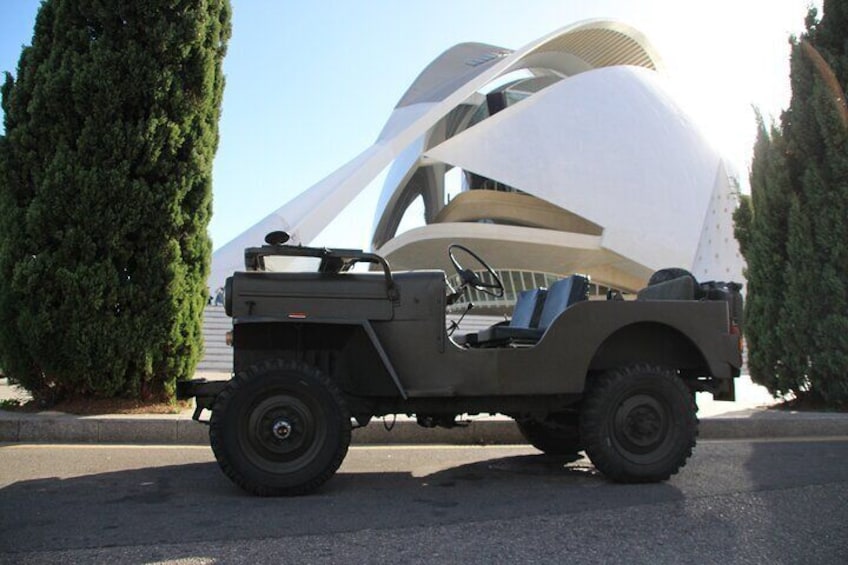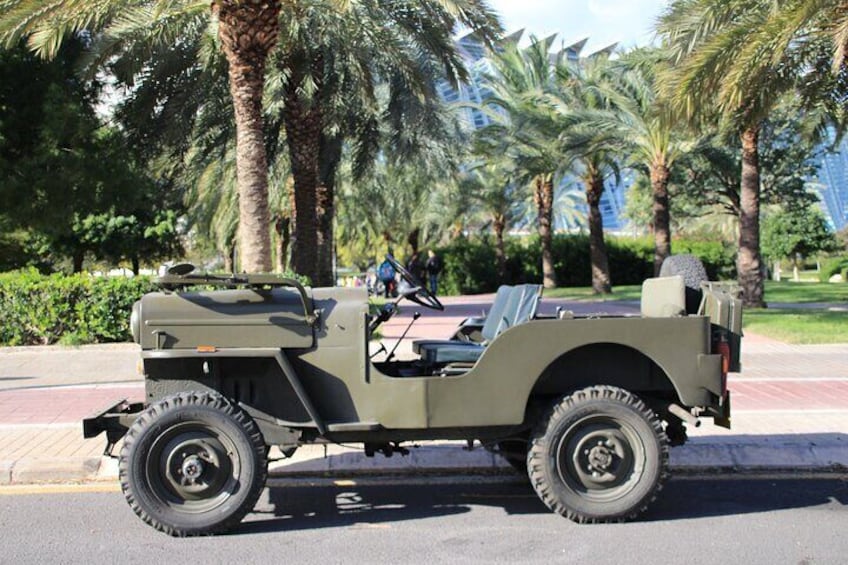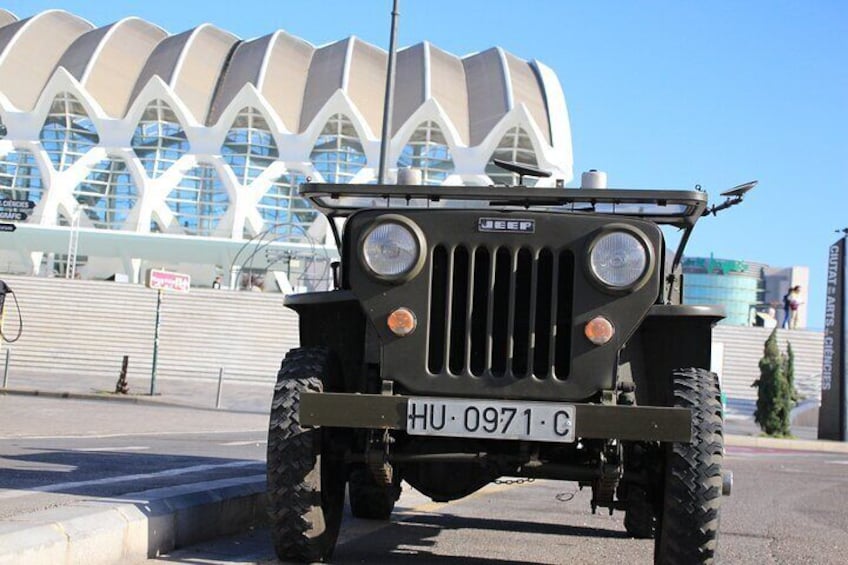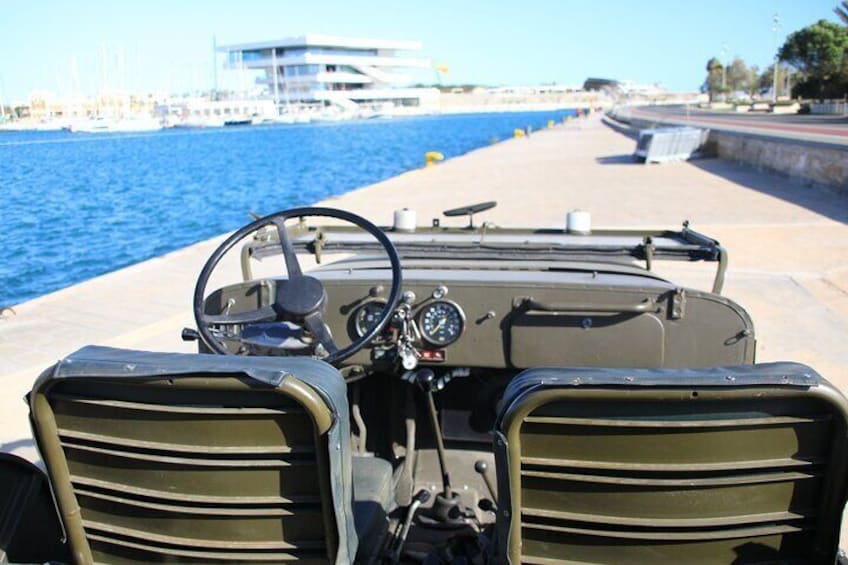List your propertySupportTrips Learn about Expedia Rewards
Learn about Expedia Rewards
Members save 10% or more on over 100,000 hotels worldwide when you’re signed in





Discover the city of Valencia in an American army jeep
By milbombastours
Free cancellation available
per adult
Features
- Free cancellation available
- 1h 20m
- Mobile voucher
- Instant confirmation
Overview
Embark on an exciting journey through Valencia with our exclusive tour in an authentic American Army Jeep. Discover the city from a unique perspective, exploring historic streets and emblematic places.
Immerse yourself in centuries of Valencian history.
Live authenticity: Experience the thrill of driving in a classic Jeep, capturing looks around the city.
Book now and join this unique experience that combines history, emotion and authenticity in every corner of Valencia
Activity location
- Plaza de Toros de Valencia
- Calle Jativa 28
- 46004, Valencia, Spain
Meeting/Redemption Point
- Plaça del Portal Nou, 6
- 6 Plaça del Portal Nou
- 46003, València, Comunidad Valenciana, Spain
Check availability
Discover the city of Valencia in an American army jeep
- 1h 20m
- Opening hours: Sat 09:00-20:00
Price details
€75.00 x 1 Adult€75.00
Total
What's included, what's not
- Snacks
Know before you book
- Public transport options are available nearby
- Suitable for all physical fitness levels
- In accordance with EU regulations about consumer rights, activities services are not subject to the right of withdrawal. Supplier cancellation policy will apply.
Activity itinerary
Plaza de Toros de Valencia
- 5m
- Admission ticket not included
The Valencia Bullring, known as the Monumental of Valencia, is an architectural jewel that fuses the bullfighting tradition with the elegance and majesty of its design. Built at the end of the 19th century, this iconic bullring is witness to exciting cultural events. With its imposing façade and a capacity to accommodate thousands of spectators, the Valencia Bullring stands as a symbol of the passion and history of bullfighting in Spain. Its vibrant atmosphere and rich heritage make it a must-see place for bullfighting lovers and fans of Spanish culture.
Torres de Quart
- 5m
- Admission ticket not included
The Quart Towers are an imposing defensive structure located in the historic centre of Valencia, Spain. Built in the 15th century, these Gothic towers were part of the old city walls. They stand out for their imposing presence and their military architecture, with details such as battlements and arrow slits. Over the centuries, the Quart Towers have resisted attacks and conflicts, becoming an important historical symbol of the city and a tourist attraction.
Barrio del Carmen
- 5m
- Admission ticket not included
Barrio del Carmen is one of the most emblematic and picturesque areas in Valencia, Spain. Located in the heart of the city's old town, Carmen is characterised by its narrow cobblestone streets, historic buildings and lively cultural life. This medieval area is home to a mix of ancient and modern architecture, with a wide variety of bars, restaurants, shops and art galleries. Its ancient walls, charming squares and artistic graffiti contribute to the authentic, bohemian atmosphere that attracts residents and visitors alike. Additionally, Barrio del Carmen is known for its vibrant nightlife, making it a popular place to enjoy Valencian cuisine, music, and culture.
Torres de Serranos
- 5m
- Admission ticket not included
The Serranos Towers are an impressive historical monument located in Valencia, Spain. Built between 1392 and 1398, these towers were part of the old medieval city walls. They stand out for their imposing stone and brick structure, shaped like a fortified gate that served as the main entrance to the city. The Serranos Towers have stood the test of time and have become an emblematic symbol of Valencia, attracting visitors who want to explore their medieval architecture and enjoy the impressive panoramic views they offer from above.
Convento de Santo Domingo
- 5m
- Admission ticket not included
In 1250, a larger church was erected in place of the original one, but this too was demolished at the beginning of the 19th century. Construction of the beautiful Gothic cloister, the oldest architectural element, began around 1300, followed shortly after by the monumental chapter house. The chapel of the Kings, which has survived to this day in its entirety, was built in 1431, while the refectory, recently restored and now used as a reception hall, began to be built in 1560. The altarpiece-shaped doorway and the Adjacent cloister that precedes the church dates from the end of the 16th century. The chapel of San Vicente Ferrer, built in the second half of the 18th century, and the main façade of the convent building, partially modified when it was used as the Captaincy General at the beginning of the 19th century, are more recent additions.
Carrer de la Pau
- 5m
Peace Street, located in the heart of Valencia, Spain, has a rich and varied history that reflects the evolution of the city over the centuries. Originally known as "Calle de San Vicente Mártir", the road underwent significant changes over the years.
In the 19th century, during the era of industrialisation, the street underwent a process of modernization and commercial expansion. The construction of the Colón Market at the beginning of the 20th century further boosted its development, becoming an important centre of economic and social activity.
During the Spanish Civil War (1936-1939), the street witnessed turbulent times, suffering significant damage. However, after the post-war period, it underwent a reconstruction that revitalised it and made it a symbol of the city's reconstruction.
Today, Peace Street is known for its architectural charm, elegant shops and vibrant atmosphere.
Plaça de la Reina
- 5m
- Admission ticket not included
El Miguelete and the Valencia Cathedral are two prominent monuments located in the heart of the city of Valencia, Spain. The Cathedral, also known as the Cathedral of Santa María de Valencia, has its roots in Roman times and was built on an ancient mosque after the Christian conquest of the city in the 13th century. Over the centuries, it has undergone various modifications and extensions, reflecting architectural styles ranging from Gothic to Baroque.
El Miguelete is the bell tower of the Cathedral and stands as an iconic symbol of Valencia. Its construction began in the 14th century and was completed in the 15th century. The tower is in the Valencian Gothic style and is characterised by its imposing height and its elaborate sculptural decoration. From its top, visitors can enjoy stunning panoramic views of the city.
Carrer del Sant Calze
- 20m
The Chapel of the Holy Chalice in Valencia has a rich and revered history dating back to medieval times. Built in the 13th century as part of Valencia Cathedral, the chapel has been revered for housing the Holy Chalice, believed to be the chalice used by Jesus Christ at the Last Supper. Over the centuries, the chapel has undergone several renovations and restorations, preserving its religious and cultural importance. The Holy Chalice has been an object of veneration and symbolism, turning the chapel into a sacred place for pilgrims and faithful from all over the world.
Mercat Central de València
- 5m
- Admission ticket not included
The Central Market of Valencia, located in the heart of the city, has its roots in the 19th century. Its construction began in 1910 and was completed in 1928, becoming one of the largest covered markets in Europe. Designed by architects Alejandro Soler March and Francisco Guardia Vial, the building stands out for its impressive iron and glass structure.
Over the years, the Central Market has witnessed the economic and social evolution of Valencia. Initially, it served as a fresh food supply centre for the city and its surroundings. Over time, the market has undergone various renovations and modernizations to adapt to the changing needs of society.
Today, the Central Market remains a cultural and gastronomic reference point in Valencia.
La Lonja de la Seda
- 5m
- Admission ticket not included
The Lonja de la Seda of Valencia, built between 1482 and 1533, is an outstanding example of Gothic civil architecture. This historic building served as a silk market and headquarters of commercial transactions in the prosperous city during the rise of the silk industry in the 15th and 16th centuries. Designed by architects Pere Compte and Joan Ibarra, the Lonja stands out for its impressive architectural style and its importance as a symbol of the economic power of Valencia at the time. In 1996, the Silk Exchange was declared a World Heritage Site by UNESCO.
Plaza del Ayuntamiento
- 5m
- Admission ticket not included
The Plaza del Ayuntamiento of Valencia, located in the heart of the city, has its origins in the 17th century. Initially called Plaza de la Ciudadela, it was used as a military space and for public celebrations. Over the years, it has undergone various urban transformations and has witnessed significant historical and cultural events. Today, the square is a central point for civic activities, festive events and houses important buildings such as the Town Hall and the Turia fountain.
Location
Activity location
- Plaza de Toros de Valencia
- Calle Jativa 28
- 46004, Valencia, Spain
Meeting/Redemption Point
- Plaça del Portal Nou, 6
- 6 Plaça del Portal Nou
- 46003, València, Comunidad Valenciana, Spain
Best Deals on Things to Do
Experience the wonders of the world up close with great deals on things to do near and far. Expedia offers one-of-a-kind activities that allow you to explore Valencia your way. Whether you love nature, culture, food or a bit of adventure, we have the perfect activity for you.
Top experiences in Valencia
With so many things to do in Valencia, planning the perfect day out may seem like a daunting task. Expedia is here to take the hassle out of finding the best attractions, tours and activities in Valencia. Families, couples and business travellers can all find the perfect activity in Valencia to create life-long memories with the help of Expedia.